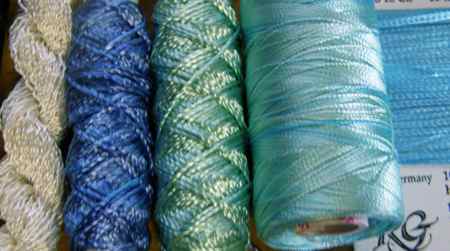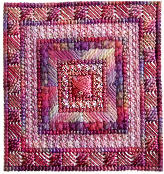- Home
- Cross Stitch
- Rayon Embroidery Thread
Crafting a Luxurious Look with
Rayon Embroidery Thread
If you've ever worked with rayon embroidery thread, you know it presents a unique set of challenges and rewards.
Known for its brilliant sheen and vibrant colours it can make even the simplest designs shine. However, its unique properties also require a bit of finesse and know-how to handle effectively.
In this article, I'll guide you through everything you need to know about rayon, from its origins to how to work with it, ensuring your projects turn out beautifully every time.

What is Rayon?
Rayon is a fascinating material with a rich history.
Unlike natural fibers like cotton or silk, rayon is a man-made fiber created from cellulose, which is derived from wood pulp. This process results in a thread that is not only lustrous but also incredibly soft to the touch.
However, rayon's beauty comes with a level of delicacy; it's more prone to fraying and breaking than some of its sturdier counterparts. Understanding these inherent qualities is the first step in learning to use this fibre in your embroidery projects.
A Love-Hate Relationship: Tips for Working with Rayon
While working with rayon can sometimes feel like wrestling with a slippery serpent, a few tried-and-true tips can help you tame this beast:
- Dampening Technique for Easier Handling: Lightly dampening rayon thread, by running it over a damp sponge or spritzing it with a spray bottle before use, can make it more manageable.
- Choosing the Right Needle: Choosing the right needle for rayon embroidery thread ensures optimal performance and helps prevent damage to the thread or the fabric.
- Securing Rayon Threads During Stitching: Due to its slippery nature, securing the thread at the beginning and end of your work is crucial to prevent unraveling.
These techniques can drastically improve your experience with rayon, turning it from a source of frustration to a favourite material.

Let's look at each of these tips in more detail.
Dampening the thread
Rayon thread tends to carry a static charge, causing it to cling to itself or the fabric, which can make it challenging to work with. A simple yet effective solution to mitigate this issue is to slightly dampen the thread.
By doing so, you're not only reducing the static charge but also enhancing the thread's pliability. This increased flexibility makes it significantly easier to pull it through the fabric, particularly when executing tiny stitches or intricate designs. Damp thread is also less likely to break during embroidery, as it becomes more resistant to friction.
However, it's crucial to find the right balance when dampening the thread. Over-wetting the thread can lead to weakness and eventual breakage due to the excess moisture.
Therefore, it's recommended to allow the thread to dry slightly before commencing your stitching. This will ensure the best results for your hand embroidery project using rayon thread.
Using the right needle
To determine if you have the perfect needle for your rayon embroidery thread, try threading the needle and working a few stitches on a scrap piece of fabric.
If the thread glides smoothly through the eye and fabric, you've found the right one. However, if you encounter difficulties, it may be necessary to try a different needle size or material.
When selecting a needle, keep in mind that those with larger eyes accommodate the slick nature of rayon thread more easily. This feature can help reduce the time and frustration often associated with threading.
For beginners or those with less steady hands, incorporating a needle threader into your embroidery toolkit can make all the difference.
Securing rayon threads during stitching
When attempting to secure your work at the start or end of a length of synthetic thread, you might find it slipping through the needle's eye, leading to loose stitches or unintended knots.
Overcoming this challenge often requires a significant amount of practice and patience, as well as potentially using tools like thread conditioners.
Stitching with shorter lengths of thread can make stitching easier.
Alternatively fold a longer length in half, then thread the ends through the eye of the needle leaving a loop at the other end. Push the needle through the fabric leaving the loop hanging at the back of the work.
When you take the needle back through, pass it through the loop and pull the thread gently until it sits snugly against your fabric.
Is Rayon Thread Colourfast?
Rayon embroidery thread is loved by embroiderers for its bright colours and sheen, enhancing any hand embroidery project. However, concerns about its durability and colourfastness have been raised, especially when compared to silk.
Historically, rayon's colourfastness was inferior to silk's, leading to potential fading with intense sunlight or frequent washing.
However, modern manufacturing advancements have significantly improved rayon's colour retention and durability, making it a reliable option for projects with minimal wear and tear.
Caring for Rayon Embroidered Pieces
Ensuring the longevity and maintaining the beauty of your rayon embroidered creations is just as important as the initial crafting process.
Given rayon's delicate nature, proper care is essential to ensure your projects remain vibrant and intact over time.
By following these care tips, you can enjoy the lustre and beauty of your rayon embroidered pieces for years to come, ensuring they remain as vibrant and captivating as the day they were completed.
Gentle washing
Hand wash your rayon embroidered items in cold to lukewarm water with a mild detergent.
Avoid wringing or twisting the fabric to prevent distortion and damage to the embroidery. Instead, gently press the excess water out and lay the item flat on a towel to dry.
Avoid harsh chemicals
Bleach and other harsh chemicals can break down the fibers of rayon thread, leading to fading and weakening of the embroidery.
Always opt for gentle, bleach-free cleaners and test them on a small, inconspicuous area first.
Ironing
If ironing is necessary, do so with a pressing cloth between the iron and the embroidered fabric.
Use a low to medium setting and avoid direct contact with the embroidery to prevent melting or distortion of the rayon threads.
Storing properly
Store rayon embroidered items in a cool, dry place away from direct sunlight to prevent fading.
If folding, place acid-free tissue paper between the folds to avoid creasing the embroidery.
For best results, consider storing flat or hanging in a garment bag to keep the embroidery in pristine condition.
Recommended Rayon Embroidery Threads
When it comes to selecting the best rayon threads for your projects, here are a few top recommendations that stand out for their quality and performance:
Anchor Marlitt embroidery floss
Perhaps the most easily obtainable rayon embroidery thread, at least here in the UK, is Anchor Marlitt. This comes in skeins and it is a 4 ply yarn. It is divisible and you can use as many strands together as you need
Brazilian embroidery threads
Brazilian embroidery traditionally uses rayon embroidery threads, of which the best quality are those manufactured by Edmar.
Edmar threads are available in various forms, ranging from fine to chunky. They are all hand-dyed and colourfast. There is no need to separate the strands. Before you stitch, pull the cut length to straighten it out.
The types available are...
- Glory, a fine 2 ply with a loose twist
- Iris, a medium 2 ply with a loose twist
- Frost, a medium 3 ply with a tight twist
- Lola, a heavy 3 ply - great for thicker branches and stems
- Cire, another heavy 3 ply, with a slightly looser twist than Lola
- Nova, a very heavy 6 ply with a loose twist, which is useful for padding
- Boucle, a nubbly textured yarn
Madeira
Madeira Decora rayon floss is sold in tangle free, 5m spiral packs and is available in 80 solid colours and 10 variegated.
Sulky rayon thread
Sulky Rayon Thread - the finer 40 wt. comes in 388 colours and the thicker 30 wt. is available in 102 (solid) and 54 (variegated) - both weights are ideal for machine embroidery or delicate hand embroidery.
In summary: Making Rayon Work for You
Rayon embroidery thread brings unmatched gloss and vibrancy to your projects, unlocking a myriad of possibilities.
By mastering its unique properties through experimentation with different brands and techniques, you can transform your work into dazzling art.
What did you think of this page?
Did it give you all you needed or did anything else spring to mind? If there was something missing give me a shout – or let me know if this page proved helpful (do let me know which page you are commenting on).
Would you like a direct reply? Just pop your email address below, and I'll be in touch.
Stay connected between projects
If you’d like occasional updates from my embroidery room, including new patterns, gentle tips, and little things I think you might enjoy, you’re warmly invited to join the Stitchin’ Times newsletter.
No pressure. Just a friendly note now and then to keep you inspired.




















